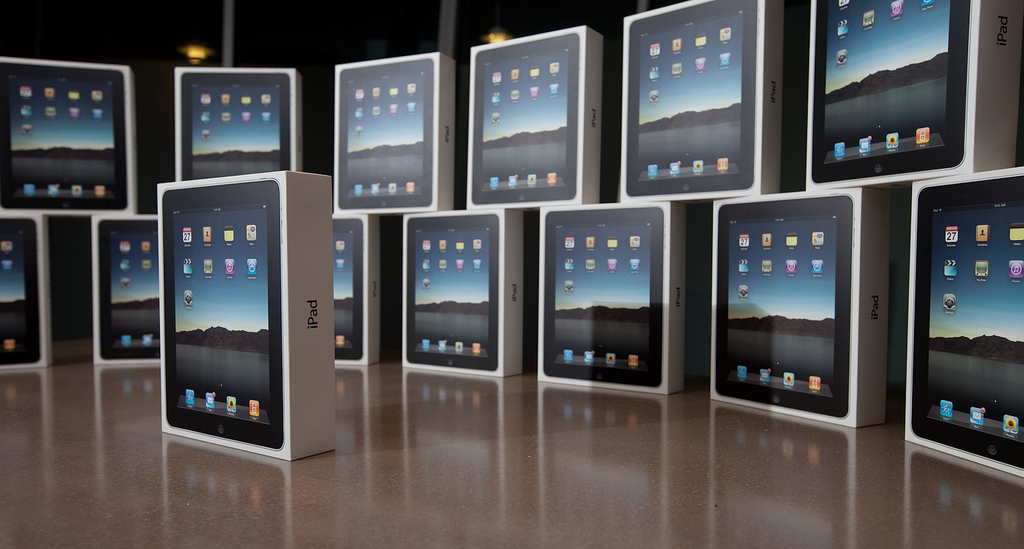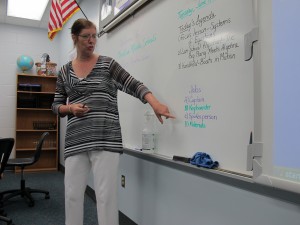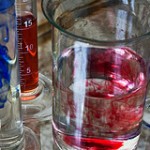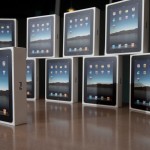Sarasota County’s High-Tech Classrooms Have A Starring Role

John O'Connor / StateImpact Florida
Actress Mayim Bialik works on math problems with Sarasota County middle school students (from left) Amanda Folsom, Daphne Waggener and Gracie Brasacchio.
The algebra problem asked the Sarasota County middle school students to figure out how much Sheldon, Amy and Howard – characters on the television show “The Big Bang Theory” – spent on tickets and popcorn while seeing “The Lord of The Rings.”
The students talked through their work in small groups around the room. A tutor helped them set up the equations.
The tutor? Mayim Bialik, who plays Amy on “The Big Bang Theory.”
“We would usually set one equal to the other and then substitute it in,” Bialik said to Brookside Middle School math teacher Brenda Fuoco. “It’s the same concept, right?”
“Absolutely, I teach them three different methods,” Fuoco said. “That’s their least favorite method.”
“Why is that their least favorite?” Bialik asked. “That’s the most logical to me?”
Bialik, 37, is known her television roles, such as the title character on the 90s sitcom “Blossom.”
Bialik has also earned a Ph.D. as a neurobiologist, taught and now works with Texas Instruments to promote science, technology, math and engineering education. But the real star of her visit Tuesday to Sarasota Middle School were new high-tech science and math classrooms.
The classrooms – called TeachActive – were a project of the Gulf Coast Community Foundation, Texas Instruments and the school district.
They are called the classroom of tomorrow, but school districts around Florida must start thinking about similar projects now. That’s because Florida law requires half of all instruction be delivered digitally by the fall of 2015. These classrooms are just one idea Sarasota County schools are trying to increase digital instruction.
The classrooms are custom-made for science and math lessons. The rooms were renovated to provide power and high-speed Internet for each workstation. Every workstation is built for small groups so students can coach each other through a lesson or task.
Students and teachers helped design the rooms, including choosing the right shape for the workstation desks from cardboard models.
In the science classroom, microscopes connect to a monitor so every student can see human blood cells or muscle tissue. Students can take screen shots and annotate the images.
At another station, a sensor captures the force data as students push themselves across the lab on their wheeled chairs.
In the math classroom, groups of four students can work together on math problems using the touchscreen computer. Math teacher Fuoco admits the demonstration is “corny,” but it works – the students dive in trying to figure out how much Sheldon and Amy spent on movie tickets and grocery items.
Sarasota County schools just completed their first year of using the new high-tech classrooms. The school district and Gulf Coast Community Foundation have renovated and equipped 50 classrooms so far – between $10,000 to $25,000, each, plus the cost of equipment – and plan to convert another 92 classrooms. The Gulf Coast Foundation says they are working on plans for similar classrooms in elementary and high schools.
Students said the new classrooms make it cool to be a math and science geek. Gracie Brasacchio said she likes that the classrooms are organized into small workstation groups.
“It helps me learn,” she said. “Instead of working separately…if I don’t understand when (the teacher) explains it, then maybe somebody at my table can explain it better for me to learn.”
The teachers like the new classrooms too.
Fuoco has been teaching 31 years and said she never wanted to be a teacher who relied on a dusty lesson book. But she was uncertain she could adjust to the new technology – especially a fancy handheld Texas Instruments calculator — and techniques. But after a year’s use?
“Love it. Love it. Love it,” she said. “It was a little daunting to me. The training has been amazing…the good thing is when you’ve got middle schoolers, if you get stuck using a calculator they can help you out.”
Bialik, too, was impressed. She said her neurobiologist kicked in watching the students work through their lessons.
“It’s emotional to see how their brains work with technology,” Bialik said. “This is a model for what schools should look like, what classrooms should look like and also what teacher engagement should look like.”



